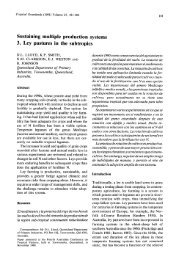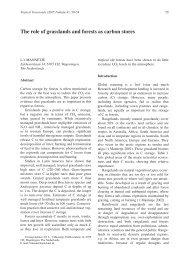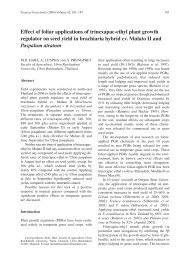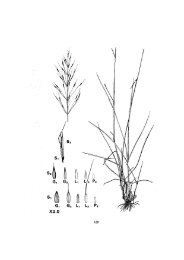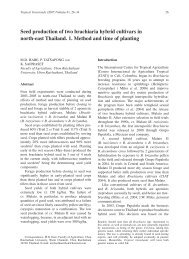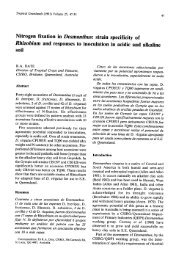Dynamics of plant populations in Heteropogon contortus - Tropical ...
Dynamics of plant populations in Heteropogon contortus - Tropical ...
Dynamics of plant populations in Heteropogon contortus - Tropical ...
You also want an ePaper? Increase the reach of your titles
YUMPU automatically turns print PDFs into web optimized ePapers that Google loves.
78 D.M. Orr<br />
native pasture although the 3 earlier papers<br />
reported data from a subset <strong>in</strong>clud<strong>in</strong>g 2 land<br />
classes (narrow-leaved ironbark and silver-leaved<br />
ironbark) at 3 nom<strong>in</strong>al stock<strong>in</strong>g rates (0.3, 0.6 and<br />
0.9 beasts/ha) <strong>in</strong> both native pasture and legumeoversown<br />
native pasture. Further details <strong>of</strong> this<br />
graz<strong>in</strong>g study are provided <strong>in</strong> Orr et al. (2004a).<br />
Site and burn<strong>in</strong>g treatment<br />
Two additional paddocks, each 6.0 ha <strong>in</strong> size, were<br />
located <strong>in</strong> a mixed narrow-leaved ironbark/silverleaved<br />
ironbark landscape and were fenced dur<strong>in</strong>g<br />
w<strong>in</strong>ter 1992. Prior to the study reported here, the<br />
areas conta<strong>in</strong>ed <strong>in</strong> these 2 paddocks were parts <strong>of</strong><br />
additional areas with<strong>in</strong> the orig<strong>in</strong>al study<br />
described <strong>in</strong> Orr et al. (2004a) and, generally, had<br />
been grazed <strong>in</strong>termittently between 1989 and<br />
1992.<br />
One beast grazed each <strong>of</strong> these 2 additional<br />
paddocks (stock<strong>in</strong>g rate <strong>of</strong> 0.15 beasts/ha)<br />
between autumn 1992 and spr<strong>in</strong>g 1995 and the<br />
pastures were burnt each spr<strong>in</strong>g (1992–1995)<br />
follow<strong>in</strong>g the first ra<strong>in</strong>fall event greater than<br />
25 mm between August and November. After<br />
burn<strong>in</strong>g <strong>in</strong> spr<strong>in</strong>g 1995, the paddocks were stocked<br />
with 2 beasts (stock<strong>in</strong>g rate <strong>of</strong> 0.3 beasts/ha) until<br />
the study concluded <strong>in</strong> autumn 1996.<br />
Measurements<br />
Population changes. In each <strong>of</strong> the paddocks, 20<br />
permanent quadrats, each 0.5 × 0.5 m, were<br />
established <strong>in</strong> W<strong>in</strong>ter 1992 <strong>in</strong> 2 nests each <strong>of</strong> 10<br />
quadrats. Measurements <strong>in</strong> these quadrats were<br />
made <strong>in</strong>itially <strong>in</strong> W<strong>in</strong>ter 1992 and subsequently<br />
each autumn until 1996 us<strong>in</strong>g procedures outl<strong>in</strong>ed<br />
<strong>in</strong> Orr et al. (2004a). Briefly, the position <strong>of</strong><br />
<strong>in</strong>dividual H. <strong>contortus</strong> and Aristida spp. <strong>plant</strong>s<br />
<strong>in</strong> each quadrat was charted us<strong>in</strong>g a pantograph<br />
(Williams 1970) and the diameter measured<br />
firstly along the widest diameter and secondly the<br />
diameter <strong>in</strong> the perpendicular direction to this<br />
widest diameter.<br />
For the other 2 treatments, population data for<br />
both H. <strong>contortus</strong> and Aristida spp. were available<br />
for each year between 1990 and 1996. However,<br />
for the purposes <strong>of</strong> the comparisons<br />
reported here, data for the 1990, 1991 and 1992<br />
<strong>populations</strong> <strong>in</strong> each <strong>of</strong> these 4 paddocks were<br />
merged and these merged data were regarded as<br />
the orig<strong>in</strong>al population. By do<strong>in</strong>g this, all <strong>populations</strong><br />
had a common start<strong>in</strong>g time <strong>in</strong> 1992.<br />
Basal area <strong>of</strong> H. <strong>contortus</strong> and Aristida spp.<br />
Basal area <strong>of</strong> H. <strong>contortus</strong> and Aristida spp. was<br />
calculated on an <strong>in</strong>dividual quadrat basis as the<br />
sum <strong>of</strong> the areas occupied by <strong>in</strong>dividual <strong>plant</strong>s <strong>in</strong><br />
the quadrat while mean <strong>plant</strong> size was determ<strong>in</strong>ed<br />
as the total area divided by the number <strong>of</strong> <strong>plant</strong>s.<br />
(Further details are provided <strong>in</strong> Orr et al. 2004a;<br />
2004c.)<br />
Seed production <strong>of</strong> H. <strong>contortus</strong>. Seed production<br />
<strong>of</strong> H. <strong>contortus</strong> was calculated as the product <strong>of</strong><br />
<strong>in</strong>florescence density and seeds per <strong>in</strong>florescence.<br />
Briefly, <strong>in</strong>florescence density was measured annually<br />
<strong>in</strong> the permanent quadrats dur<strong>in</strong>g late March<br />
between 1993 and 1996. The number <strong>of</strong> seeds per<br />
<strong>in</strong>florescence was determ<strong>in</strong>ed annually from 5<br />
<strong>in</strong>florescences collected at random from each<br />
paddock. (Further details are provided <strong>in</strong> Orr et al<br />
2004b.)<br />
Soil seed bank <strong>of</strong> H. <strong>contortus</strong> and Aristida spp.<br />
The soil seed banks <strong>of</strong> H. <strong>contortus</strong> and Aristida<br />
spp. were estimated <strong>in</strong> spr<strong>in</strong>g each year between<br />
1992 and 1995 by germ<strong>in</strong>at<strong>in</strong>g seed conta<strong>in</strong>ed <strong>in</strong><br />
soil cores collected from the areas surround<strong>in</strong>g<br />
the permanent quadrats. Briefly, 4 cores, each<br />
5 cm diameter and 5 cm deep, were bulked to produce<br />
each sample and there were 15 samples (i.e.<br />
60 cores) from each paddock. In the subsequent<br />
summer, each sample was spread as a th<strong>in</strong> layer<br />
on top <strong>of</strong> sand <strong>in</strong> a 15 cm diameter dra<strong>in</strong>ed plastic<br />
pot and seed <strong>in</strong> these samples was germ<strong>in</strong>ated by<br />
water<strong>in</strong>g with an overhead spr<strong>in</strong>kler for 30 m<strong>in</strong>utes<br />
daily <strong>in</strong> a glasshouse (Orr et al. 1996). Seedl<strong>in</strong>gs<br />
were identified and counted after 6 weeks.<br />
(Further details are provided <strong>in</strong> Orr et al. 2004b).<br />
Data analysis<br />
Data were analysed by standard analysis <strong>of</strong><br />
variance as a completely randomised design with<br />
3 treatments and 2 replications. Plant survival<br />
was analysed us<strong>in</strong>g a proportional hazards survival<br />
model (Cox 1972).<br />
Results<br />
Seasonal conditions<br />
The overrid<strong>in</strong>g climatic condition throughout the<br />
study at “Glenwood” was drought with 6 consecutive<br />
years <strong>of</strong> below average ra<strong>in</strong>fall start<strong>in</strong>g <strong>in</strong>




